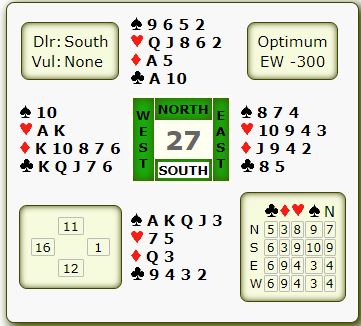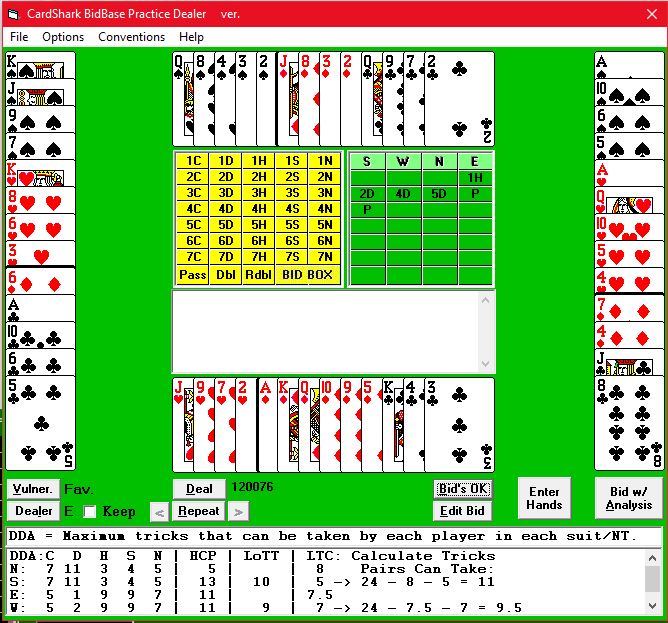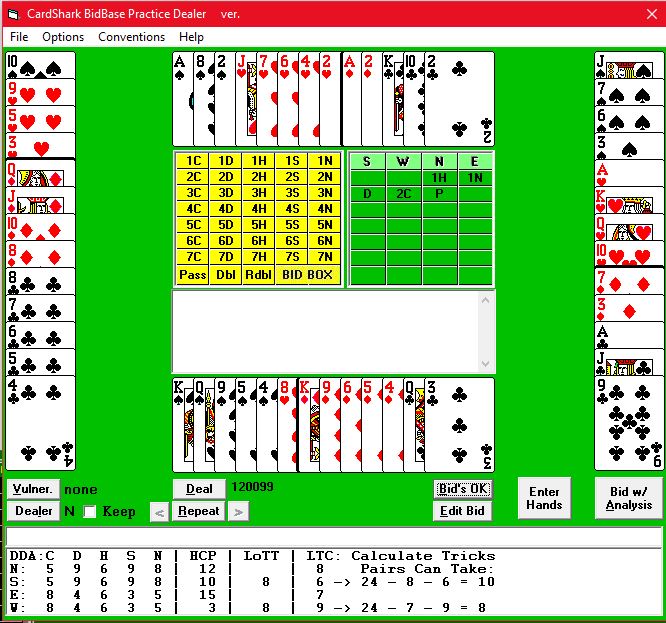Forcing Pass
A forcing pass is a pass made when the side bidding clearly has the balance of the points and the passer wants to leave the final bidding decision to partner.
A forcing pass can only take place when the passer's Right Hand Opponent has bid since otherwise the bidding could end before it gets back to passer's partner.
A typical example would be (where 4 is a game forcing splinter):
is a game forcing splinter):
Responder must either bid on or double. If opener then bids again, referred to as a Pass And Pull, he is showing an interest in slam; otherwise, he should just bid instead of making a Forcing Pass the first time.
Another example is in Bridge Bulletin, May, 2019, p.54:
The hand:  AQJ432
AQJ432  7
7  KQ82
KQ82  Q9
Q9
Bidding: 1 -3
-3 -4
-4 -5
-5 ; Pass
; Pass
Partner's 4 cue bid shows a stronger hand than just bidding 4
cue bid shows a stronger hand than just bidding 4 , but it's still hard to know just how strong.
, but it's still hard to know just how strong.
Rather than guess at what partner has, leave it to him to decide whether to bid 5 , 6
, 6 or Double. Boehm says to pull a double to 5
or Double. Boehm says to pull a double to 5 as a slam try since with no interest in slam, you would have bid 5
as a slam try since with no interest in slam, you would have bid 5 instead of passing on your prior bid.
instead of passing on your prior bid.
From Bridge Bulletin, Aug. 2010, It's Your Call
The hand:  J64
J64  AQJ54
AQJ54  T32
T32  K9
K9
Bidding: 1 -3
-3 -4
-4 -5
-5 - ??
- ??
The top vote getter was a Forcing Pass. The Bulletin said
You assume that your side has the balance of power after partner’s cue¬bid at the four level. When that is the case, the normal bid is to double at the five level with two or more quick losers in the opponents’ suit. The majority chose instead to pass.
With 3+ diamonds, partner could easily be void in diamonds and all of my cards are working in other suits.
The explanation above is rather over-simplified. There are numerous variations of the Forcing Pass and it must be discussed with partner first to agree on when a pass is a Forcing Pass.
An example of not coming to an agreement first is this deal:
 South was dealer and the bidding went
South was dealer and the bidding went
1 (2N) 4
(2N) 4 (P)
(P)
P (5 ) P
) P  (P)
(P)
P
West's 2N bid showed 5-5 in the minors. Playing North, I jumped to 4 because that's what I figured we could make even if partner had a minimum and I wanted to block East from chiming in.
because that's what I figured we could make even if partner had a minimum and I wanted to block East from chiming in.
After West bid 5 , I made what I thought was a Forcing Pass because I figured that partner should realize that my 4
, I made what I thought was a Forcing Pass because I figured that partner should realize that my 4 was a sign-off bid to make and I had nothing to add to that. I expected partner to bid 5
was a sign-off bid to make and I had nothing to add to that. I expected partner to bid 5 with the kind of hand she had with very little defense and to double with a hand like QJT932-A2-KQx-Kx which has good defense but poor offense.
with the kind of hand she had with very little defense and to double with a hand like QJT932-A2-KQx-Kx which has good defense but poor offense.
Unfortunately, we had not discussed Forcing Passes and partner thought my bid was preemptive.
In hindsight, I was the one with weak trumps and outside strength and I should have doubled. This would have informed partner that my 4 was based on outside strength rather than being a preempt, but with her hand, she probably should bid 5
was based on outside strength rather than being a preempt, but with her hand, she probably should bid 5 anyway.
anyway.
Of course, if I had doubled, East probably would have corrected to 5 (which should have been done anyway) and then South could have either bid 5
(which should have been done anyway) and then South could have either bid 5 or passed it around to me.
or passed it around to me.
Either way, the real problem was our failure to discuss Forcing Passes and come to an agreement.
Because there are so many variations, rather than try to repeat them all here, these are some links:
 This deal comes from the June 1, 2020, Aces bridge column by Bobby Wolff which focused on Forcing Passes.
This deal comes from the June 1, 2020, Aces bridge column by Bobby Wolff which focused on Forcing Passes.
Wolff says that the 4 Splinter bid by West sets a game force for E-W and thus East's subsequent Pass is a Forcing Pass.
Splinter bid by West sets a game force for E-W and thus East's subsequent Pass is a Forcing Pass.
As we can see from the Double Dummy Analysis at the bottom, N-S can actually make 5 while E-W can only take 9 tricks in hearts. Since E-W are vulnerable and N-S are not, N-S making 5
while E-W can only take 9 tricks in hearts. Since E-W are vulnerable and N-S are not, N-S making 5 doubled would be a bad score for E-W while E-W going down 2 at 5
doubled would be a bad score for E-W while E-W going down 2 at 5 doubled would also be a bad score against an undoubled, nonvulerable game by N-S.
doubled would also be a bad score against an undoubled, nonvulerable game by N-S.
This means that for this deal, Forcing Pass only serves to secure a bottom for E-W.
What can be learned from this? Well, West's Splinter normally shows 13-15 points - not HCP, but total points. Subtracting the points for West's known singleton or void in diamonds, he can have as few as 10-11 HCP.
East's opening bid of 1H can be made with as few as 11 HCP, giving E-W a total of only 21-22 HCPs. With dummy points, E-W might have enough for 4 (though not this time) but are unlikely to have enough to make 5
(though not this time) but are unlikely to have enough to make 5 . At IMPs, you might want to risk a double, but not at matchpoints.
. At IMPs, you might want to risk a double, but not at matchpoints.
The bottom line is that when West (in this example) has well described his shape and HPC, it is up to East to either bid or double, if either. A pass should not be forcing on West.
When I emailed Bobby Wolff about the above, he quickly and graciously responded:
When you open and partner makes a limit+ response, you are justified in assuming that your side has 25+ HCP (and thus are in the Forcing Pass range).
You may have to pay off to the opponents making a five-level contract now and then, but that if they don't make their bid occasionally, you aren't doubling enough.
Playing Forcing Pass gives you much more flexibility at the five level.
However, in the Feb. 2022 issue of Bridge Bulletin, p. 67, Billy Miller says an opening bid opposite a limit raise does not create a forcing pass situation.
Miller also says that  1H
1H  D
D  2H
2H  2S, 4
2S, 4 -4
-4 does not create a FP situation because partner could have bid 4
does not create a FP situation because partner could have bid 4 with a weak but very shapely hand, so it is not clear who has the balance of HCP.
with a weak but very shapely hand, so it is not clear who has the balance of HCP.
Part Score Forcing Pass
 A FP does not have to be at the game level. The following hand was from Bobby Wolff's June 4, 2020, newspaper column:
A FP does not have to be at the game level. The following hand was from Bobby Wolff's June 4, 2020, newspaper column:
After N opened 1 and E overcalled 1N, S's double showed that N-S had more than half the points and thus should not stop bidding below the 2 level. So after W saved to 2
and E overcalled 1N, S's double showed that N-S had more than half the points and thus should not stop bidding below the 2 level. So after W saved to 2 , N's pass was forcing - made because he had nothing more to add to his original bid.
, N's pass was forcing - made because he had nothing more to add to his original bid.
After E passed too, S was forced to bid to bid and said 2 .
.
Since E had shown 15-17 HCP, it was barely possible that S had enough for game, so N's 3 invite was not unreasonable, but S's 4
invite was not unreasonable, but S's 4 (in the actual game) seems ambitious and the DDA shows that it shouldn't make.
(in the actual game) seems ambitious and the DDA shows that it shouldn't make.
Since N's pass was only forcing through the 2 level, S wasn't forced to bid on.
>